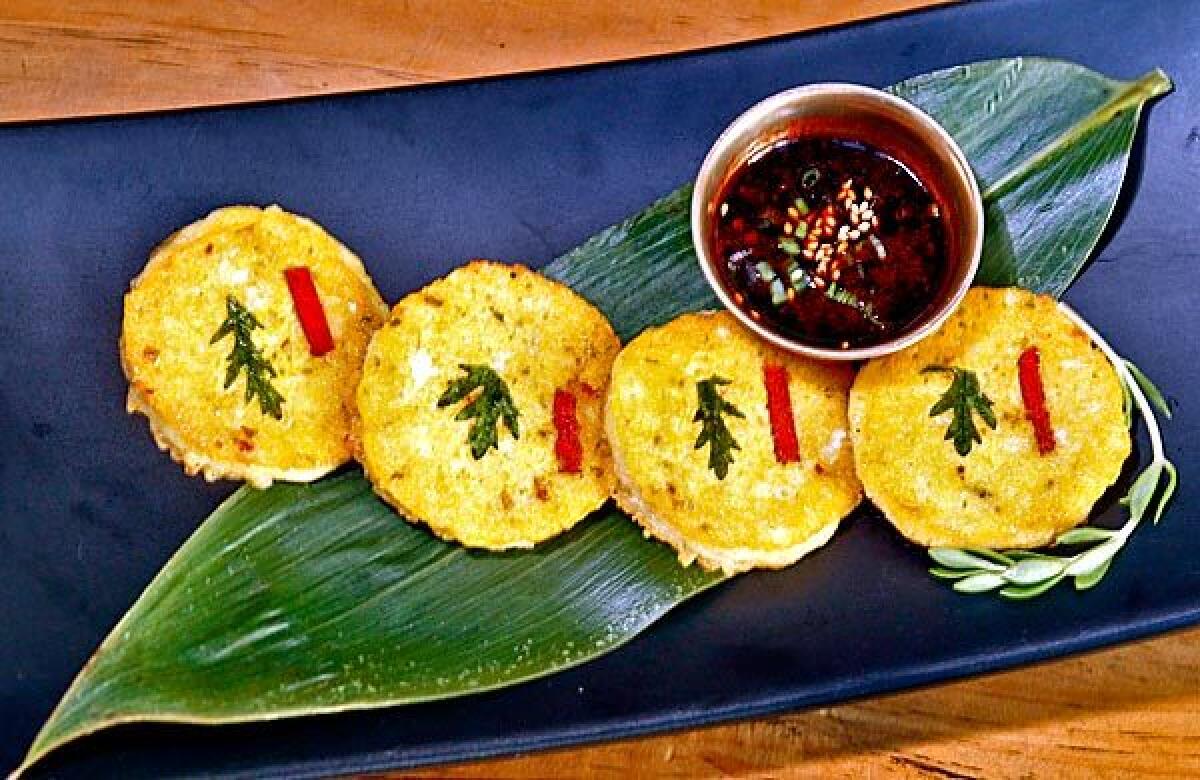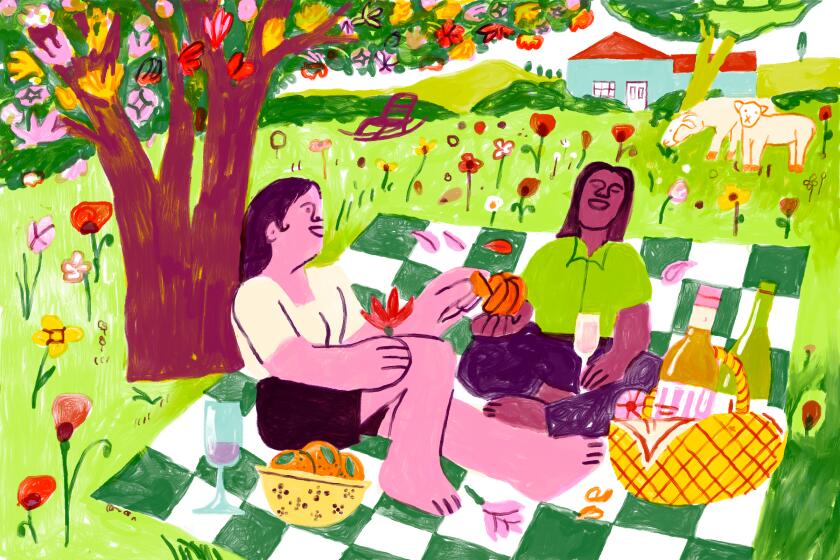The Review: Bann Restaurant & Lounge in Koreatown

- Share via
A block from the Wiltern, giant ivory silk lanterns in crystalline geometric shapes and finished with a tassel hang from the double height ceilings. The floor stretching ahead is marble, the appointments are a mix of traditional and contemporary Korean elements, which is what the menu is too. Right now, the new Bann Restaurant & Lounge may be the splashiest place in Koreatown.
Just inside the entrance, a bartender shakes up a Manhattan and then pours out soju for another guest. A handful of smartly dressed Asians sit at the tall communal table in front of the open kitchen sipping sake or soju and sampling small plates while watching the chefs in tall, starched white hats perform. This is no Benihana showmanship, though, simply cooks going about their business.
The Choi family that brought Korean food into the mainstream here in Los Angeles with its two upscale Woo Lae Oak restaurants is back with a new concept at the very spot where its story began. The food is a mix of traditional dishes and artfully presented contemporary fare that attempts to bring some of the elements of trendy Asian fusion restaurants to Koreatown with mixed success.
The clientele, at least until now, just months after opening, seems to be primarily Korean, attracted by the sleek look of the new restaurant with its semi-private booths and marble tabletops inset with smokeless charcoal grills. No hoods, though. These grills quietly and efficiently suck up the smoke just below table height. At more down-home Korean barbecue joints, such as Soot Bull Jeep on 8th Street, it’s a risk to show up in your finest threads. They come home smelling of smoke and sometimes littered with minuscule holes from the sparks.
At one table, a man wearing a fine leather jacket, big gold watch and giant aviator glasses — his version of “late Elvis”? — sweet-talks his flattered girlfriend over beef tartare with sesame oil and Asian pear. At another, three slender young Korean women with the appetites of stevedores talk and laugh over hot pot and barbecue, their chopsticks poised to beat each other out for the best morsels.
Small packages
The highlight of the menu is the array of cold and warm small plates that can be ordered separately or in groups of three. Some are traditional. Many are not. Of course we have to try the pa jun, a pancake loaded with scallions and various seafood. Think of it as the Korean equivalent of a frittata, which can be made plain with vegetables or with kimchi for those who can’t get enough of the hot, garlicky pickle. Though I enjoy the seafood pa jun, it’s a little oily. Even better, though, are the mini mung bean pancakes — more like crepes than pancakes, in a way, almost like socca, the chickpea flour crepes from the South of France.
More unusual are the lettuce packets stuffed with minced, sautéed chicken gizzards. They have an earthy funk that’s delicious. Go chu are slender peppers stuffed with whitefish and cut open on the diagonal showing off the stuffing (which can be beef as well). I liked the thinly sliced conch tossed with slivered Asian vegetables, but a raw fish dish something like sashimi doesn’t have much flavor. And mandu, the Korean equivalent of pot stickers, are just OK, nothing special.
Order any of the grilled barbecue items and you’ll get a modest array of side dishes, including three different kimchi, each at a different stage, from very aged to fresh and sharp. Salad is iceberg lettuce with a sweet, vinegary dressing.
Barbecue items are fairly standard — beef short rib, rib-eye, pork tenderloin, shrimp, calamari, tripe, etc. Kalbi (short rib) is good quality but not exceptional, and the portion seems a bit smaller than at other Korean barbecue restaurants. But the thinly sliced tongue is exceptionally flavorful when it’s cooked long enough to get caramelized at the edges.
One would have to camp out at the restaurant for months to get through the large menu. The hot pots are a good bet, comforting, somehow, to add ingredients to the pot and watch them cook, fishing each morsel out when it’s done, with the broth getting more intense all the while. One night there’s a sumptuous black cod, rich and oily.
Disappointing tofu
When we notice the chef personally serving something from a portable table to a party of four, we’re curious about what it is. The artisanal tofu, says our waiter. Do you want some? We order it with black sesame (you can order it several different ways), but unfortunately it’s a big disappointment, nothing like the custardy, silky texture of Japanese tofu. This one is bland curds, with very unappealing looks. I don’t think it’s just me: My Korean friends didn’t like it either.
Korean restaurants generally are not big on desserts, and what they do have require more of an acquired taste. But if you have a hankering for a little something sweet at the end of the meal, get the tropical snow, a shaved coconut ice mountain crowned with red bean paste and jellied fruit.
The majority of Koreatown restaurants are small places with Formica tables and fluorescent lighting, terrific if you’re looking for a cheap meal and a bowl of noodles or some tofu. Bann sets itself apart with a menu of moderately innovative Korean food and a stylish setting where you can have a leisurely dinner in pleasant surroundings.
That said, if you’re hoping for a thrilling take on Korean cooking like at, say, David Chang’s at Momofuku or Ssam Bar in New York, this isn’t it. Bann is more sedate and much less bold in its cooking, but it still takes one step forward in giving us something more than the same-old, same-old.
Bann Restaurant & Lounge
Rating: ✭ 1/2
Location: 623 S. Western Ave., Los Angeles; (213) 384-2244; https://www.bannrestaurant.com.
Price: Starters, $8 each or three for $21; starters for sharing, $10 to $21; barbecue items, $18 to $27; traditional entrees, $18 to $28; hot pots, $22; rice and noodle dishes, $5 to $18; soups and stews, $12 to $18; dessert, $6 to $8. Corkage fee, $20.
Details: Open from 11:30 a.m. to 10 p.m. Monday to Thursday and from 11:30 a.m. to 11 p.m. Friday to Sunday. Happy hour, 4 to 7 p.m. daily. Valet parking, $2.
irene.virbila@latimes.com
More to Read
Eat your way across L.A.
Get our weekly Tasting Notes newsletter for reviews, news and more.
You may occasionally receive promotional content from the Los Angeles Times.







